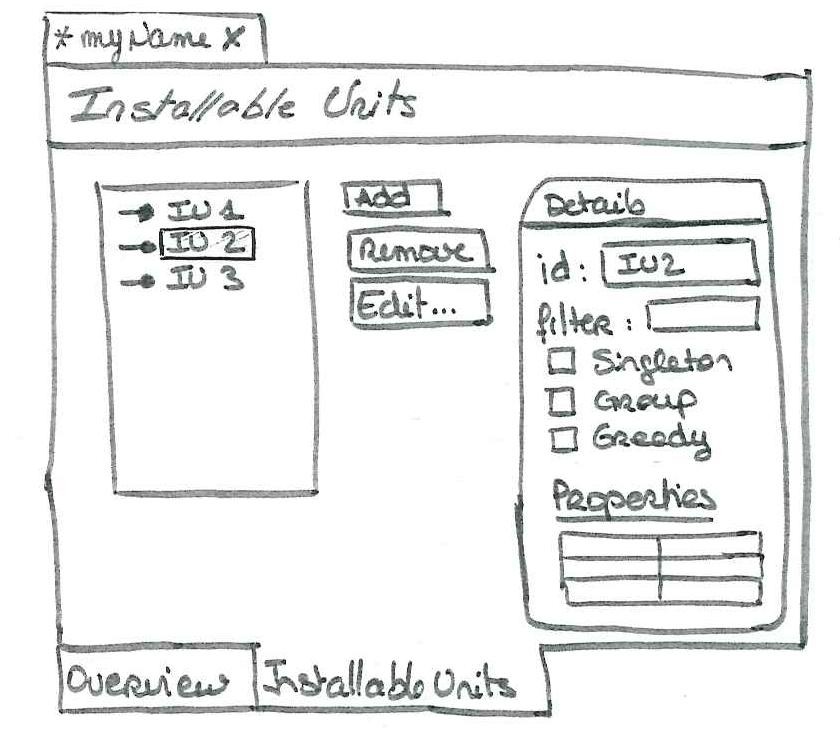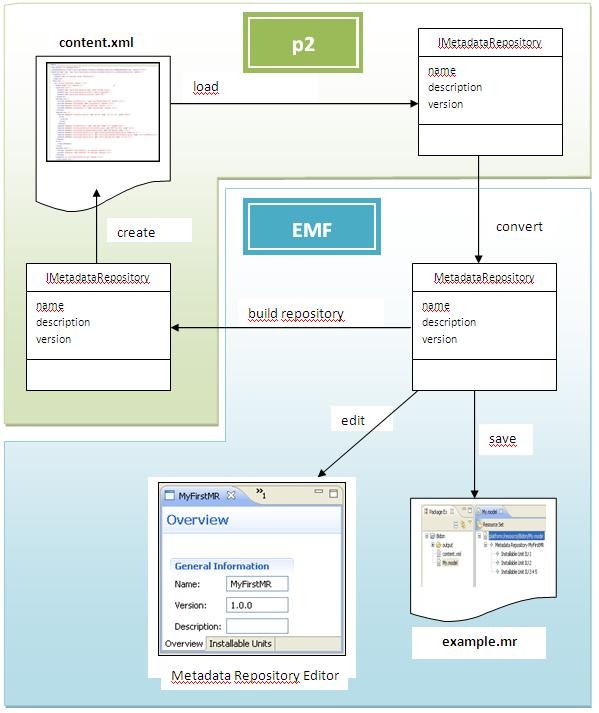Notice: this Wiki will be going read only early in 2024 and edits will no longer be possible. Please see: https://gitlab.eclipse.org/eclipsefdn/helpdesk/-/wikis/Wiki-shutdown-plan for the plan.
Equinox p2 Metadata Repository Authoring
Introduction
Purpose
The aim of this document is to list and explain some functionalities needed for a Metadata Repository Editor.
Context
In Eclipse 3.4 context, a new framework, named p2, replaces the Update Manager. Anyware wants to provide to team leaders a user-friendly tool, to help them to manage an "œunder control" Eclipse configuration for all the team members.
Such a tool will be a Metadata Repository Editor, allowing user to easily configure a file named content.xml, provided by an update site to install/update softwares in Eclipse.
A [p2-dev] mailing-list member, Henrik Lindberg, has developed an editor (http://wiki.eclipse.org/Equinox_p2_Metadata_Authoring) to allow users to easily configure an Installable Unit, which is a part of a Metadata Repository. We will explain how we will include this tool in ours.
Acronyms and abbreviations
| |
|
|---|---|
| |
Installable Unit : a part of a Metadata Repository. It contains required and provided capabilities, artifacts, touchpoints... |
| |
Eclipse Modelling Framework |
| |
Model-View-Controller |
Editor general description
General behavior
This editor is a standard Eclipse editor. It allows to edit a Metadata repository object, and to save it as a content.xml file.
Once the user has set some parameters required for his project, he can provide an Update Site for members of a team, allowing them to use the same Eclipse context.
Users
Users are project managers, team leaders, system administrators...
Use case scenario.
Scenario 1:
The team leader wants to set a unique configuration for all his team members. He knows that the project will require some libraries or plug-ins sets: resources that p2 calls Installable Units.
Through an Eclipse wizard, he builds a new Update Site Model : it creates a new .mr file. This file is the input file our Metadata Repository Editor expects.
Then in editor view, a multi page editor is opened, inviting the user to fill or customize what he wants to.
The first tab is an Overview of the Metadata Repository : name, description, version... A button allows to build a concrete update site form the currently edited .mr file.
The second tab allows to add/edit/remove IUs for this repository. This tab is a kind of Master/Details, to quickly see and edit some relevant properties on the selected IU. For a complete IU edition, the user click on "Edit" button to open another editor, provided by Henrik Lindberg. This is inspired by the Update Site editor, where double-clicking on a feature opens the editor for this feature.
General constraints of architecture
To make simple a data binding mechanism between the model (a repository) and the previous interface, we decided to use EMF
But, as p2 models are not designed by EMF, we make the choice to not modify p2 APIs with EMF. So a p2 IMetadataRepository is first converted into an EMF model. This EMF model is edited with our Metadata Repository Editor, and saved as a .mr file. That's why we include in the editor the opportunity to "build" the Metadata Repository: the EMF Metadata repo EObject, is converted into a p2 object, and we use p2 API to serialize this p2 object to an xml file.
Detailed description
Data description
Here is an Ecore diagram, showing the data model behind the editor.
The Metadata Repository Editor will allow to edit some of the MetadataRepository attributes, and the installableUnits relation.
Installable Unit edition will be delegated to another editor. Some properties and attributes will be still editable in the Metadata Repository Editor.
User Interfaces
Our Metadata Repository editor is a multi-tab page, displayed in the Eclipse editor view.
- 1st tab must allow to edit general properties for the repository
- 2nd tab must display Installable Units for the repository
- It must open a more detailed editor when editing an IU. This operation can be performed with a button and/or a double-click on an IU.
- It must support an undo/redo mechanism
- The tab title in the editor view must display a dirty marker (*) when modifications have been done.
- The editor must flag incorrect values, such as incorrect value number,
- The editor must disallow any Save operation while editors has incorrect values
Wizard for new Metadata Repository
A wizard is necessary to allow the user to create a repository from scratch.
- The wizard shall be available in File/New/p2/Metadata Repository.
- It shall ask for
- .mr file name : mandatory field
- Repository name : mandatory field, a user friendly name for the metadata repository
- Repository version : default to 1.0.0
- Validating the wizard must initialize a new simple project (no peculiar nature), containing a .mr file, and directly open the Metadata Repository Editor for the new created file.
Export/Import a model
- After editing a Metadata Repository, the user should be able to export it as a p2 Metadata Repository, building a content.xml file.
- In the other way, the user should be able to load an existing p2 Metadata Repository, giving a valid content.xml file.
These options could be available by 2 ways :
- A right click on the .mr file could display 2 specific options :
- "Build Metadata Repository" : the user should add some installable units to the current repository; otherwise a repository has no sense. So if the user clicks on this option, if no installable unit is associated, the user is invited to add any installable unit. If any installable unit is filled for this repository, clicking on this option open a popup asking the user where he wants to deploy its site. Once the location is entered, a file content.xml is generated at this place. This file contains all information filled through our editor.
- "Load Metadata Repository" : build a .mr file from a content.xml file (location given by the user), to edit its contents through the editor.
- 2 icons in overview tab could allow the user to perform an import or export.
Overview page
Here is a sketch of how the first tab could be like.

Overview tab display those fields.
- Name is default filled with the repository name from the wizard
- Description is a summary for the metadata repository
- Version is the current version for the metadata repository
- Type is not displayed, but set to org.eclipse.equinox.internal.p2.metadata.repository.LocalMetadataRepository (TBD)
Installable units page
Here is a sketch of how the second tab could be like.

- On the left, a list viewer must display all IUs associated to the current repository. For a new repository, this list is empty. The list can be displayed as a Tree, using the IU group property to build such an organization.
- Add button :
- Always enabled.
- Allows to add an installable unit, using a dialog to select them from a distant site, or IU present in the workspace (.iu file ?).
- Remove button :
- Enable only when any IU is selected.
- Remove the association between the edited repository and the selected IU.
- Edit button :
- Enable on only when any IU is selected and when this IU is available as a .iu file in the user's workspace
- Uses another editor (maybe Henrik Lindberg's one : org.eclipse.equinox.p2.authoring).
- When closing this other editor, our editor shall be consequently updated.
Details section displays some details about the selected IU. They can be updated. Properties are also available here (this is not the case in the external IU editor). The user can add new ones or override them.


